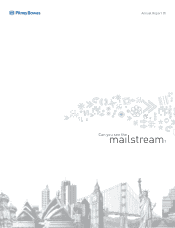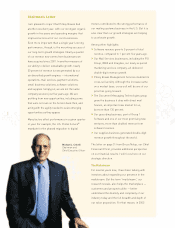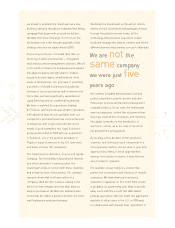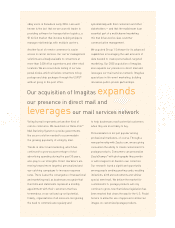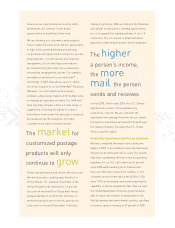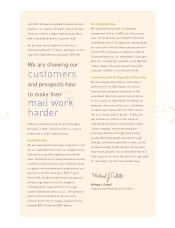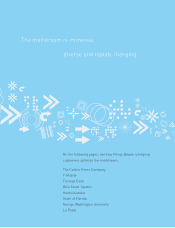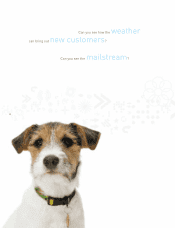Pitney Bowes 2005 Annual Report Download - page 5
Download and view the complete annual report
Please find page 5 of the 2005 Pitney Bowes annual report below. You can navigate through the pages in the report by either clicking on the pages listed below, or by using the keyword search tool below to find specific information within the annual report.
3
we moved to establish the mailstream as a new
business category through an integrated marketing
campaign that began with an event we held at
the New York Stock Exchange. Our focus on the
mailstream now is the natural outgrowth of the
strategic direction we established in 2000.
As you may recall, we concluded then that our
future lay in what we know best — integrated
mail and document management solutions. We set
out to build on these core businesses and expand
into adjacent spaces, through small-to-midsize
acquisitions and organic investments in other
areas of the business. Our goal was to assemble
a portfolio of related businesses and add new
streams of recurring revenue with minimum risk.
Since then, we have significantly expanded our
capabilities beyond our traditional businesses.
We have completed 56 acquisitions totaling
$1.7 billion, launched a steady stream of products
with advanced features not available from our
competitors, and developed new services tailored
to industries with unique mail and document
needs. A good example is the Legal Solutions
group we launched in 2005 with our acquisition
of Compulit, one of the premier providers of
litigation support services to top U.S. law firms
and many
Fortune
100 companies.
The mailstream is immense, diverse and rapidly
changing. Far from being eclipsed by the Internet
and other channels of communication, the
mailstream works in concert with these channels
and enhances their effectiveness. For example,
research shows that first-time visitors to a
company’s Web site who receive a catalog in the
mail from that company are more than twice as
likely to purchase at the Web site. Research also
shows that the higher a person's income, the more
mail that person sends and receives.
We define the mailstream as the almost infinite
variety of mail, documents and packages moving
through the global economy today; all the
technology and processes required to create,
track and manage this diverse content; and all the
different channels that senders can use to distribute
this content, including national posts, licensed
postal competitors, private carriers and even
messenger services and facilities management
companies like us. In our view, the mailstream
even encompasses content like documents that
never get inserted into envelopes, and channels
like digital networks for the distribution of
electronic content, as in the case of electronic
bill presentment and payment.
By looking at this broader communications
universe, and looking at each component in a
more granular fashion, we are able to spot new
opportunities. Many of these opportunities
emerge from global economic trends that are
easy to take for granted.
For example, we are living in a culture that
prefers the convenience and efficiency of remote
commerce. We have developed numerous
solutions to capitalize on this trend. Best known
is probably our partnership with eBay to provide
eBay users with the world’s first Web-based
postage application. We first made this application
available to eBay users in the U.S. in 2004 and,
in collaboration with Canada Post, extended it to
We are not the
same company
we were just five
years ago

